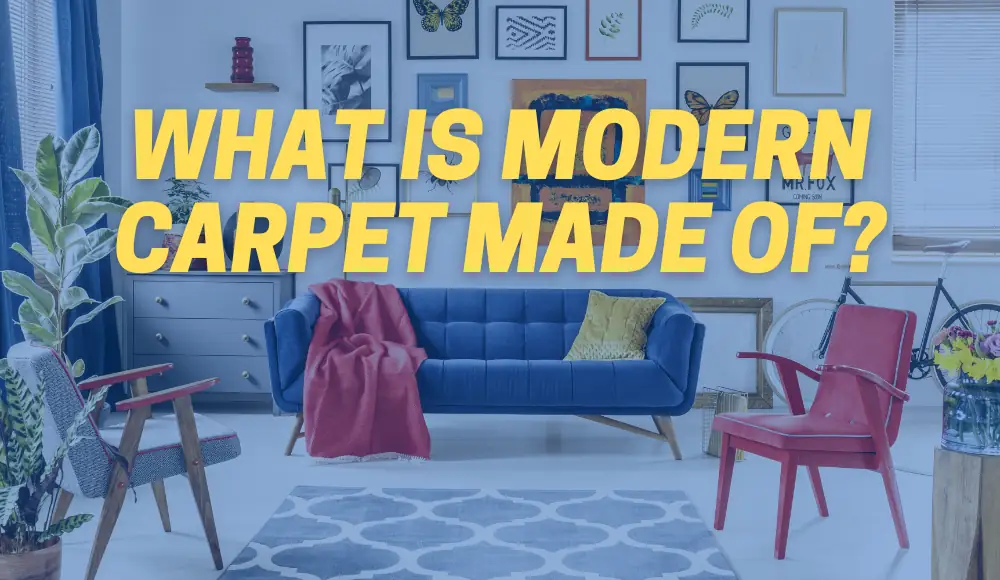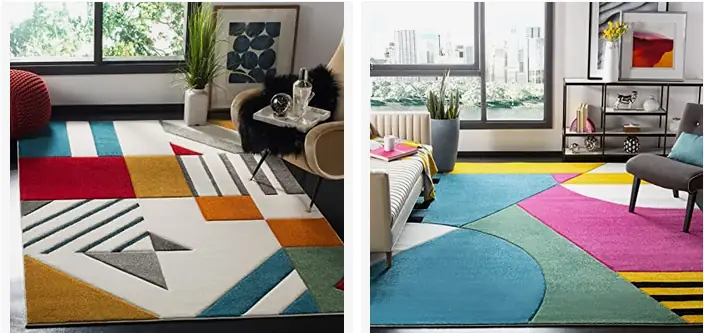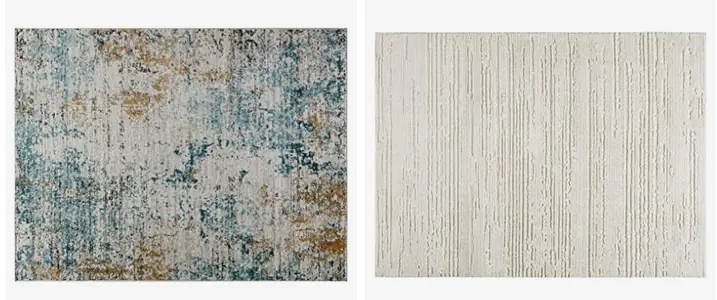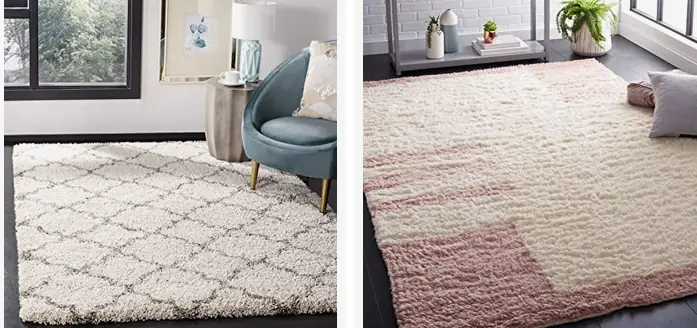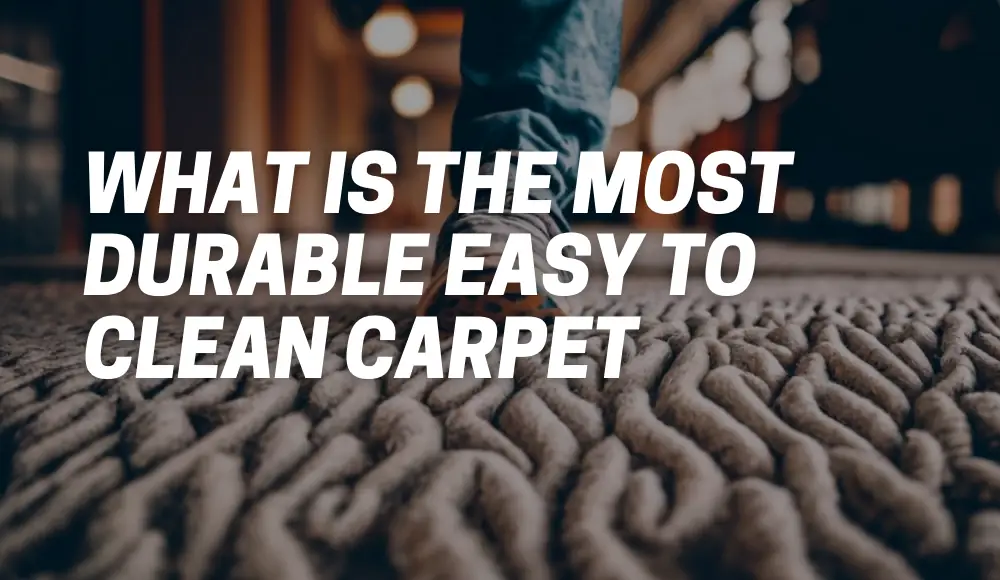Carpeting is an essential element in interior design, adding warmth, comfort, and style to our homes. When it comes to choosing the perfect carpet, it’s crucial to understand what is modern carpet made of to ensure we make an informed decision.
In this article, we will explore the composition of modern carpets, highlighting the significance of materials, the rise of synthetic options, and alternatives to traditional carpeting. So, let’s dive in and unravel the secrets of modern carpet!
How do I know what my carpet is made of?
Determining the composition of your carpet can be a puzzling task.
However, with a little guidance, you can become a carpet detective and uncover the materials that make up your beloved flooring.
Here are a few simple methods to identify the composition of your carpet:
- Manufacturers’ Information: Start by checking the manufacturer’s label or any accompanying documentation. These resources often provide valuable insights into the materials used in your carpet’s construction.
- Professional Assistance: If the manufacturer’s information is unavailable or unclear, consider consulting a professional carpet installer or an expert in the field. They possess the expertise to analyze the carpet’s composition based on its appearance, texture, and other visual cues.
- Burning Test: While we don’t encourage playing with fire, a controlled burn test can offer some clues about the materials used in your carpet. By carefully igniting a small piece of the carpet’s fiber in a controlled environment, you can observe the behavior of the flame and the resulting ash or residue.
Remember, the goal is to gather accurate information about your carpet’s composition to make informed decisions about cleaning, maintenance, and future purchases.
What is Modern Carpet Made of?
Modern carpets are composed of a variety of materials carefully chosen for their durability, comfort, and aesthetic appeal.
Let’s explore the primary components of modern carpeting:
- Synthetic Fibers: One of the most common materials used in modern carpets is synthetic fibers. These fibers, such as nylon, polyester, and polypropylene, offer exceptional strength and stain resistance, making them ideal for high-traffic areas and households with pets or children. Synthetic carpets are also more affordable than their natural counterparts, making them a popular choice among homeowners.
- Natural Fibers: While synthetic fibers dominate the carpet industry, natural fibers still hold their ground. Materials like wool, sisal, and seagrass offer a luxurious and eco-friendly option for those seeking a more sustainable carpeting solution. Natural fiber carpets provide excellent insulation, are naturally hypoallergenic, and have a distinct texture and visual appeal.
- Backings and Padding: Behind the visible layer of carpet lies the backing, a crucial component that provides stability and durability. Backings are typically made of materials like woven polypropylene or jute. Additionally, carpet padding, placed between the carpet and the subfloor, adds cushioning, insulation, and noise reduction.
- Dyes and Treatments: To achieve vibrant colors and enhance stain resistance, modern carpets often undergo dyeing processes and treatments. Stain-resistant treatments like Scotchgard™ are commonly applied to synthetic carpets to repel spills and make maintenance easier. It’s important to note that the use of dyes and treatments can vary depending on the specific carpet manufacturer and their production methods.
Modern carpets blend these components together to create a flooring solution that meets the demands of contemporary lifestyles while offering a wide range of choices in terms of aesthetics, performance, and cost-effectiveness.

What is Synthetic Carpet?
Synthetic carpet, as the name suggests, is made from artificial or man-made fibers.
These fibers are engineered to replicate the characteristics of natural materials while offering enhanced durability and stain resistance.
Let’s take a closer look at the most common types of synthetic fibers used in carpet manufacturing:
- Nylon: Nylon is the most popular synthetic fiber in carpet production, renowned for its exceptional strength and resilience. It can withstand heavy foot traffic, making it an excellent choice for busy households. Nylon carpets are also known for their ability to retain vibrant colors and resist fading.
- Polyester: Polyester fibers are highly versatile and widely used in carpet manufacturing. They offer excellent stain resistance and come in a variety of colors, making them a popular choice for homeowners seeking vibrant and visually appealing carpets. Additionally, polyester is known for its softness and luxurious feel underfoot.
- Polypropylene (Olefin): Polypropylene, also known as olefin, is a synthetic fiber valued for its affordability and resistance to moisture and staining. Carpets made from polypropylene fibers are often used in outdoor or high-moisture areas due to their water-resistance properties. However, they may not be as durable as nylon or polyester options.
- Acrylic: Acrylic fibers are commonly used as an alternative to wool, offering a similar appearance and softness. While acrylic carpets are less expensive than wool, they may not possess the same level of durability or stain resistance. Nevertheless, acrylic carpets provide a budget-friendly option for those seeking a wool-like aesthetic.
Synthetic carpets have gained popularity in modern interior design due to their affordability, durability, and wide range of design options.
They offer a practical solution for households seeking long-lasting flooring without compromising on style.
The best modern nylon carpet can vary in price quite significantly, depending on its size and of course quality.
Natural Fibers: Wool, Silk, Cotton
When it comes to carpet making, natural fibers are a popular choice. Wool is the most common of the natural fiber choices for carpets because it is durable and resilient.
Wool can bounce back after being flattened by foot traffic and furniture weight.
It also has a natural resistance to staining because its fibers are naturally moisture-repellent, which means that it does not absorb spills as readily as synthetic fibers.
Silk is another luxurious natural fiber used in carpets but is less common due to its high cost. The softness and luxury of silk add an elegant touch to any room and feel wonderful underfoot.
Cotton is another option for carpet making but is usually blended with wool because it lacks durability on its own.
Overall, both natural and synthetic fibers offer their own unique advantages when it comes to carpet-making materials. Choosing which type will depend on your preference for look, feel, and durability.
Advantages and Disadvantages of Natural Fibers
Durability and resilience of wool
Wool is one of the most popular natural fibers used in modern carpets. It is highly durable and resilient, which means it can withstand heavy foot traffic without showing signs of wear and tear.
Wool fibers have a natural crimp, which gives them a springy texture that helps them maintain their shape over time. Wool carpets are also naturally resistant to stains, fire, and water damage.
However, wool carpets also have some downsides. They are often more expensive than synthetic fiber carpets, making them less accessible to budget-conscious consumers.
Wool can also be difficult to clean if it gets heavily soiled or stained. Additionally, wool fibers can shed over time, leading to the formation of dust bunnies and contributing to indoor air pollution.
Softness and luxury of silk
Silk is another natural fiber that is sometimes used in modern carpet manufacturing. Silk fibers are known for their softness and luxurious feel underfoot.
Silk rugs can add elegance and sophistication to any room in the home. However, there are some drawbacks to using silk in carpeting as well.
For one thing, silk is a delicate material that cannot withstand heavy foot traffic as well as other types of carpet fibers. It is also prone to staining and water damage, which means it may not be the best choice for high-traffic areas or households with young children or pets.
Breathability and absorbency of cotton
Cotton is a popular natural fiber used in modern carpet production because it has excellent breathability and absorbency properties. Cotton rugs can help regulate humidity levels inside homes by absorbing moisture from the air. They’re also easy to clean since they’re machine-washable most times.
However, like other natural fibers mentioned earlier like wool and silk, cotton is not without its disadvantages. Cotton carpets are lightweight and tend to bunch up or slip on hard floors, which can be a safety hazard.
They are also susceptible to mold growth if they get too wet or aren’t dried properly after cleaning. Cotton carpets may not be as durable as synthetic fiber carpets and may need to be replaced more frequently over time.
Advantages and Disadvantages of Synthetic Fibers
Stain resistance and easy maintenance of nylon
When it comes to synthetic fibers, nylon is one of the most popular choices for modern carpets. It’s not hard to see why: nylon is incredibly durable, resistant to stains, and easy to maintain.
If you have pets or children running around your home, then nylon might be the ideal choice for you. Nylon fibers have a resilient structure that allows them to bounce back after being stepped on or crushed by furniture.
This means that your carpet will retain its original appearance and shape over time. Nylon carpets are also highly resistant to staining.
Unlike natural fibers such as wool or silk, nylon can be treated with stain-resistant coatings that repel spills and make cleaning up messes a breeze. If you accidentally spill something on your carpet, you can simply clean it up with a damp cloth without worrying about leaving behind any unsightly stains.
Affordability and versatility of polyester
Polyester is another popular synthetic fiber used in modern carpets, known for its affordability and versatility. Polyester carpets are typically less expensive than those made from other synthetic materials such as nylon or olefin.
This makes them an excellent choice if you’re working within a tight budget but still want a high-quality carpet for your home. In addition to being affordable, polyester fibers are also extremely versatile.
They can be dyed in almost any color imaginable, allowing homeowners to choose from a wide range of hues and patterns when selecting their carpeting. Polyester carpets are also soft underfoot, making them comfortable for walking or playing on.
Water resistance and durability of olefin
Olefin is another popular synthetic fiber used in modern carpets due to its water resistance and durability. Olefin fibers are naturally hydrophobic which means they resist absorbing water.
This makes them ideal for areas of the home that are prone to moisture, such as basements or bathrooms. In addition, olefin is incredibly durable and resistant to wear and tear.
It can withstand heavy foot traffic without showing signs of wear and tear, making it an ideal option for high-traffic areas in your home. Olefin carpets are also resistant to stains, mold, and mildew, making them an excellent choice for anyone looking for a long-lasting and low-maintenance carpeting option.
Tufting: The Manufacturing Technique Behind Modern Carpets
Loop Pile vs. Cut Pile: What’s the Difference?
When it comes to carpet manufacturing, there are two types of piles: loop and cut.
Loop pile carpets are made by creating loops of yarn that are either left intact or cut at a uniform height. Cut pile carpets, on the other hand, have their loops cut in order to create individual tufts of yarn.
Each type has its own benefits and drawbacks. Loop pile carpets tend to be more durable because the loops can withstand wear and tear without showing signs of damage. They’re also great for high-traffic areas because they don’t show footprints or vacuum marks as easily as cut pile carpets do.
Cut pile carpets, on the other hand, tend to be softer and more luxurious because each tuft is plusher than a simple loop would be.
Machine vs. Hand-Tufted Carpets
Once the type of pile has been chosen, modern carpet manufacturing techniques revolve around either machine or hand-tufting methods. Machine-tufted carpets are created using large machines that can weave hundreds of yards of carpet per day.
These machines work by feeding strands of yarn through needles that push them through a backing material in a predetermined pattern.
Hand-tufted carpets, on the other hand, require skilled craftsmen who use handheld tools to pull loops or tufts of yarn through a backing material one at a time.
This process is much slower than machine tufting but allows for greater customization since each tuft can be placed individually.
Advancements in Tufting Technology
Over time, modern carpet manufacturers have continued to develop new technologies and techniques for both machine and hand-tufting processes alike. Some advancements include laser-guided machines that improve accuracy during production and computerized design tools that allow for greater customization of carpet patterns.
One exciting development in tufting technology is the introduction of 3D tufting machines, which can create carpets with different pile heights and textures.
This type of machine allows for even more creativity and innovation in modern carpet design. As new technologies continue to emerge, the possibilities for modern carpet manufacturing only continue to expand.
How do you make brown carpet look modern?
Brown carpets can evoke a sense of warmth and coziness in a space, but if you’re aiming for a more modern and contemporary look, there are several strategies you can employ.
Here are some tips to transform your brown carpet and give it a modern makeover:
- Layer with Area Rugs: Introduce area rugs with bold patterns or vibrant colors to break up the monotony of a brown carpet. Opt for rugs that complement the overall color scheme of the room while adding a contemporary touch.
- Play with Contrast: Incorporate contrasting elements into the room’s design to make the brown carpet stand out in a modern way. Choose furniture, curtains, and wall colors that provide a striking contrast to the carpet, creating visual interest and a sense of balance.
- Embrace Minimalism: Emphasize clean lines, sleek furniture, and a minimalist approach to decor. A modern aesthetic often embraces simplicity and clutter-free spaces, allowing the brown carpet to serve as a neutral foundation while other design elements take center stage.
- Integrate Modern Accessories: Add modern accessories like metallic accents, geometric shapes, or abstract artwork to infuse a contemporary vibe into the space. These elements can divert attention from the carpet and create a cohesive modern look.
Remember, design is subjective, and personal preferences play a significant role in creating a modern look.
Experiment with different combinations and styles until you find the perfect balance that suits your taste and complements your brown carpet.
What is a Modern Alternative to Carpet?
While carpets have long been a staple in interior design, there are alternative flooring options that offer a modern twist.
Here are a few popular alternatives to traditional carpeting:
- Hardwood Flooring: Hardwood floors provide a timeless and elegant look that suits a variety of design styles, from classic to contemporary. They offer durability, easy maintenance, and a range of wood species, colors, and finishes to choose from.
- Laminate Flooring: Laminate flooring offers a cost-effective alternative to hardwood while mimicking its appearance. It consists of multiple layers of synthetic materials, topped with a printed layer that resembles wood or other natural materials. Laminate is known for its durability, scratch resistance, and easy installation.
- Vinyl Flooring: Vinyl flooring has undergone significant advancements in recent years, making it a popular choice among homeowners. It comes in a variety of styles, including luxury vinyl tiles (LVT) and vinyl planks, which can mimic the look of hardwood or stone. Vinyl is highly durable, water-resistant, and easy to clean, making it suitable for high-traffic areas and moisture-prone spaces.
- Tile Flooring: Tile flooring, such as ceramic or porcelain tiles, provides a versatile and modern flooring solution. Tiles are available in various colors, patterns, and sizes, allowing for endless design possibilities. They are durable, easy to maintain, and well-suited for areas with high moisture, such as bathrooms and kitchens.
- Concrete Flooring: Concrete floors have gained popularity in contemporary design for their sleek and minimalist appeal. They can be polished, stained, or stamped to achieve different textures and finishes. Concrete flooring offers durability, low maintenance, and the flexibility to incorporate radiant heating systems.
Each of these alternatives offers its own set of advantages and design opportunities, allowing homeowners to create a modern and stylish living space that aligns with their preferences.
Environmental Impact of Modern Carpets
The production of carpets can have a significant impact on the environment due to the materials used and waste generated.
Synthetic fibers, such as nylon and polyester, are made from petroleum-based products which are non-renewable resources and release harmful greenhouse gases during production.
Additionally, carpet manufacturing can contribute to water pollution through the use of chemicals in dyeing and finishing processes.
Eco-friendly Carpet Options
Fortunately, there are eco-friendly options available for those who want to minimize their environmental impact. One option is to choose carpets made from recycled materials.
These can be made from recycled plastic bottles or old carpets that have been repurposed into new ones. In addition, some companies now offer biodegradable carpets which are designed to decompose naturally over time.
Recycled Materials
Carpet manufacturers have started producing eco-friendly carpets using post-consumer recycled content such as discarded plastic bottles. They reclaim these plastic containers by breaking them down into small pellets which are then spun into fibers that look and feel like traditional carpeting material.
Biodegradable
Biodegradable carpets are another environmentally friendly option available in today’s market. These rugs break down naturally over time without releasing harmful pollutants into the environment. They’re typically made from natural substances like wool or bamboo fiber which can be easily composted at the end of their useful life.
Conclusion
Understanding the composition of modern carpets is essential when making informed decisions about your flooring choices.
Synthetic and natural fibers, combined with backings and treatments, come together to create carpets that meet the demands of contemporary lifestyles. Synthetic carpets offer durability and affordability, while natural fibers provide a luxurious and eco-friendly option.
If you’re looking to refresh the appearance of your brown carpet, consider incorporating contrasting elements, layering with area rugs, and embracing minimalist or modern accessories.
Alternatively, explore modern alternatives to carpets, such as hardwood, laminate, vinyl, tile, or concrete flooring, which offer a fresh and contemporary approach to interior design.
By staying informed about the materials and options available, you can confidently select the perfect flooring solution that not only meets your aesthetic preferences but also enhances the overall comfort and style of your home.
